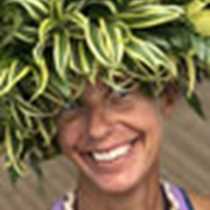Lake Eva, Peril Straits
This morning the National Geographic Sea Bird dropped the hook in Hanus Bay. On the Northeastern corner of Baranov Island we explored the verdant temperate forest and walked among huge hemlocks. In the denizen of bruin this sleepy hollow of primeval nature provided us a good taste of old growth forest and the cycles of life that depend on its state of health and equilibrium. Through the primordial soup of muck and mud we explored the river's edge. Evidence of deer were observed in the grazed leaves of skunk cabbage, hollow guard hairs on the ground and a pile of bones, remnants of a natural demise or one of predator prey. Learning that bears frequent this area when the salmon are running later in the season, it comes as no surprise that deer would be a healthy substitute for the coastal brown bear that dominates the food chain.
On the lower end of the food chain we encountered the quintessential mega mollusk that helps to bring the story of the forest to life. The banana slug is one of the largest slugs in the world and seems to be a subject some naturalists love to share. Not only do they have a fascinating story of reproduction but also a voracious appetite. Consuming fungus, feces, carrion and lichen (with their 28,000 some odd teeth) they are an important player in the ecology of returning nutriment to the flora of the forest.
Kayakers explored the shoreline as the rising tide filled the inner reaches of Hanus Bay, allowing paddlers to explore the outlet of Lake Eva.
Back on the ship we reluctantly cleaned our boots of mud and muck leaving the forest behind with vivid impressions of the temperate rainforest that makes this part of Alaska so unique and special. Lifting anchor we then cruised the length of Peril Straits through Serguis Narrows en route to our final port of call. Peril Straits was named after the unfortunate death of enslaved Aleuts who were relocated to Sitka to hunt otter. In 1799 these native Alaskans lost their lives after eating mussels exposed to paralytic shellfish poisoning.
It has truly been a tremendous week full of wild things and great camaraderie. While the wind always seemed to be in our face rather than at our backs we persevered in the elements and embraced what nature offered. Leaving the National Geographic Sea Bird in Sitka tomorrow we will return to the place where we came from with a greater appreciation and sense of place for wild Alaska.
This morning the National Geographic Sea Bird dropped the hook in Hanus Bay. On the Northeastern corner of Baranov Island we explored the verdant temperate forest and walked among huge hemlocks. In the denizen of bruin this sleepy hollow of primeval nature provided us a good taste of old growth forest and the cycles of life that depend on its state of health and equilibrium. Through the primordial soup of muck and mud we explored the river's edge. Evidence of deer were observed in the grazed leaves of skunk cabbage, hollow guard hairs on the ground and a pile of bones, remnants of a natural demise or one of predator prey. Learning that bears frequent this area when the salmon are running later in the season, it comes as no surprise that deer would be a healthy substitute for the coastal brown bear that dominates the food chain.
On the lower end of the food chain we encountered the quintessential mega mollusk that helps to bring the story of the forest to life. The banana slug is one of the largest slugs in the world and seems to be a subject some naturalists love to share. Not only do they have a fascinating story of reproduction but also a voracious appetite. Consuming fungus, feces, carrion and lichen (with their 28,000 some odd teeth) they are an important player in the ecology of returning nutriment to the flora of the forest.
Kayakers explored the shoreline as the rising tide filled the inner reaches of Hanus Bay, allowing paddlers to explore the outlet of Lake Eva.
Back on the ship we reluctantly cleaned our boots of mud and muck leaving the forest behind with vivid impressions of the temperate rainforest that makes this part of Alaska so unique and special. Lifting anchor we then cruised the length of Peril Straits through Serguis Narrows en route to our final port of call. Peril Straits was named after the unfortunate death of enslaved Aleuts who were relocated to Sitka to hunt otter. In 1799 these native Alaskans lost their lives after eating mussels exposed to paralytic shellfish poisoning.
It has truly been a tremendous week full of wild things and great camaraderie. While the wind always seemed to be in our face rather than at our backs we persevered in the elements and embraced what nature offered. Leaving the National Geographic Sea Bird in Sitka tomorrow we will return to the place where we came from with a greater appreciation and sense of place for wild Alaska.




